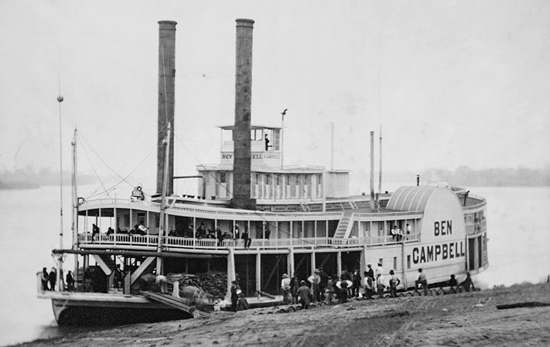The Confidence Man
Melville's The Confidence-Man: His Masquerade was published on April Fools' Day in 1857 and unless you are fascinated by Melville, it's utterly unreadable. But it's my favorite.
The setting is the Fidèle, a Mississippi steamboat, in an era when a boat or railroad served to move the narrative along and populated it with interesting characters engaged in conversation. This was an era of rapid westward colonization, with immigrants, traveling salesmen, guest speakers, politicians and missionaries all on the move. The Confidence Men, all of them...
Most of Melville's novels are travel narratives on whaling boats or men-of-war, but it's not a common literary device and it's rarely successful commercially. It doesn't even work in movies. Chaucer's The Canterbury Tales was only successful because of the individual stories told by the pilgrims on horseback, not because of its overarching form. On top of that, one of Melville's intentions in The Confidence-Man is to satirize the form itself, which of course alienates most readers.
The steamboat shown here in the 1850s plied the Upper Mississippi River around Galena.

The novel also contains what I consider to be a veiled but sustained attack on the Mormons, at a time when the public mood in America had taken a nasty turn against them. LDS scholars are fascinated by this...
The book opens with a reference to Manco Capac, one of the Quetzalcoatl-like American gods cited by Mormons to defend their version of American pre-history and the whole book is laden with serpent imagery. There's a reference to "Mormons" being on the boat and to a "green prophet from Utah" (not a compliment) and there’s a "man in the gray coat and white tie" whom some have taken to be a portrait of Joseph Smith, although he could be any of the avatars really. There's more, but the best of all are two chapters on an encounter between a seemingly Mormon missionary with a "brass-plate" and a philosopher from Missouri, in which their debate about "saints" and the "man-child" seem like references to Mormon ideas of eternal progression. The "chilled" Missourian is left wondering if he just conversed with Death himself.
That chilled Missourian could have been Mark Twain who was a Mississippi steamboat pilot at the time The Confidence-Man was published and Twain's younger brother Henry met death himself the following year when the steamboat he was working on, the Pennsylvania, exploded.
Twain covers the Mormons in Roughing It (1872) which is when he dubbed The Book of Mormon "chloroform in print." I like to think he modeled those confidence men The King and Duke of Adventures of Huckleberry Finn on the King of Nauvoo and aspiring presidential candidate...

This is Twain in 1871 when his hair was still dark. Also see his take on Adam and Eve here.
